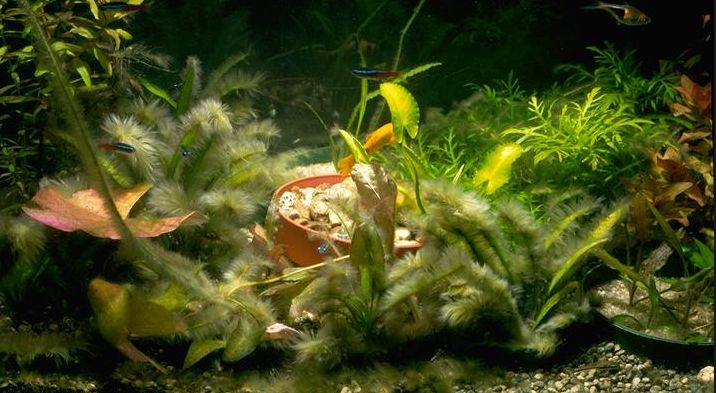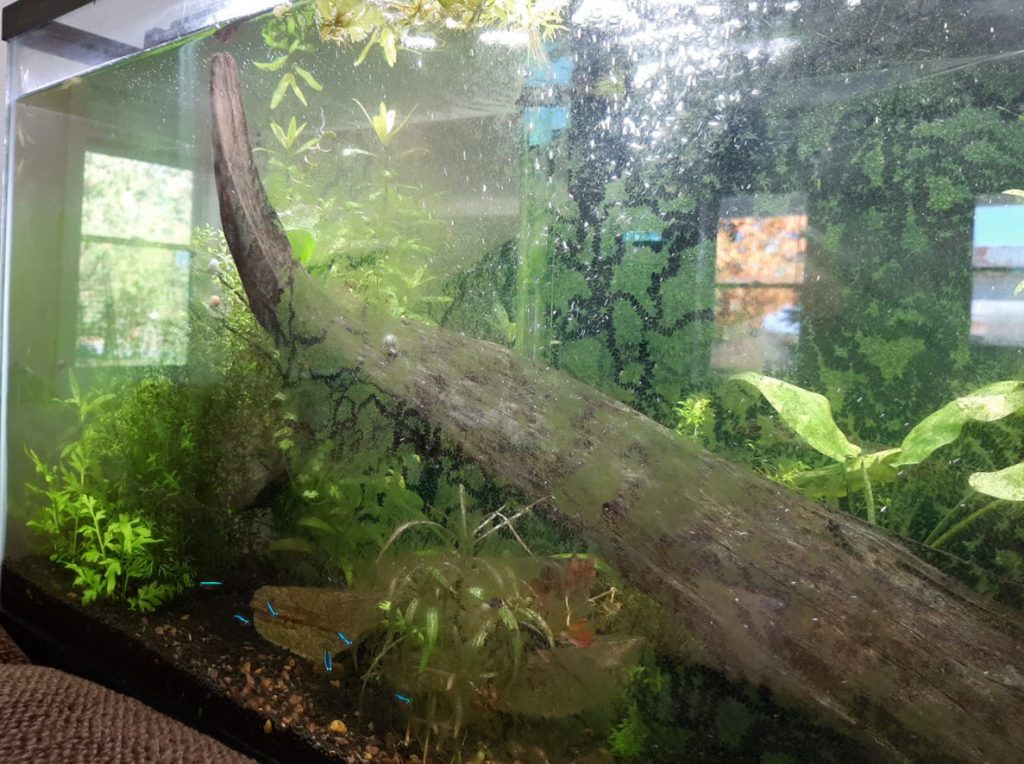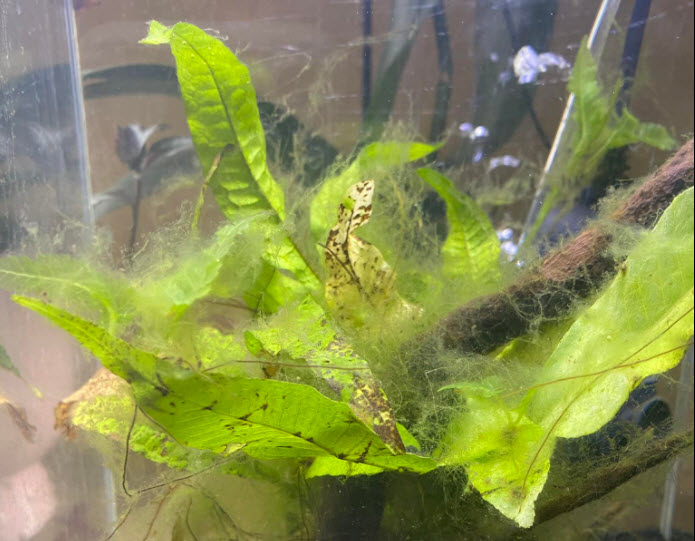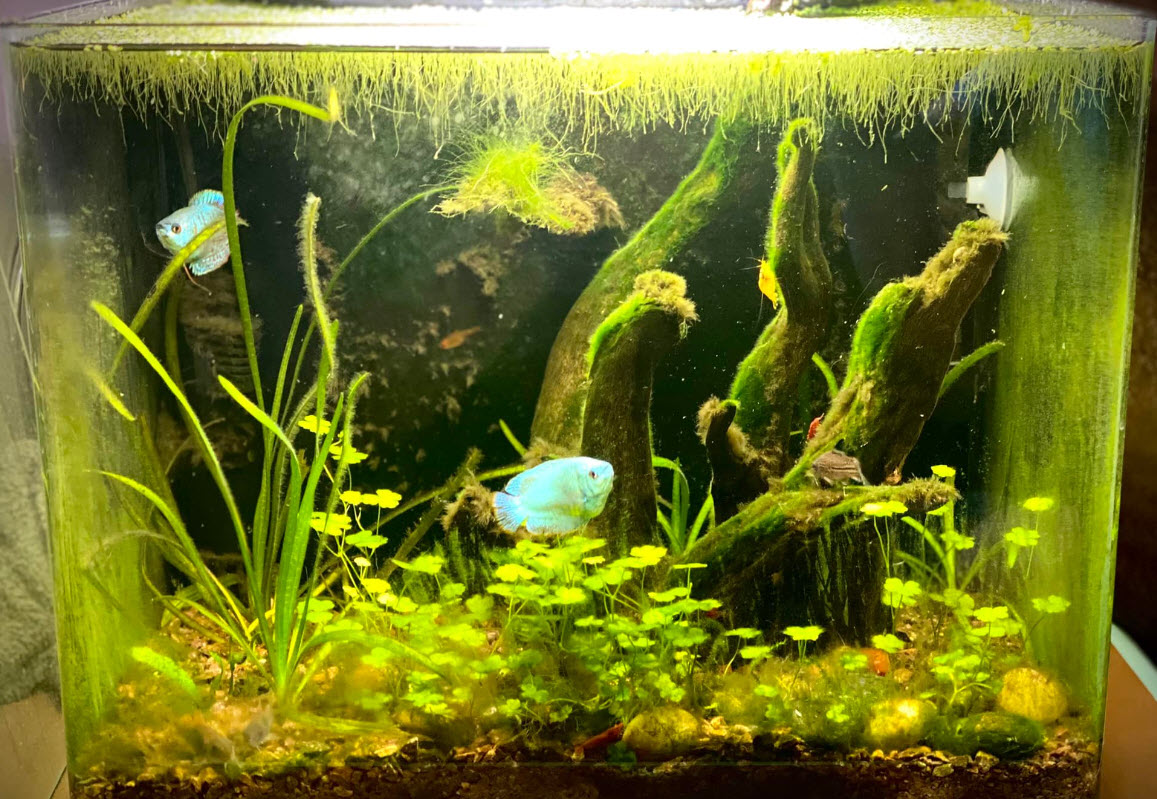
Algae are a problem for most fish keepers. The problem is that most “newbies” try to fight the algae and eliminate it from their aquarium. This is simply impossible. The best way to fight algae is to keep nitrates low in the aquarium with water changes. This also keeps phosphorus low in the aquarium. This LIMITS the algae growth in the aquarium, it does not stop it. A fish keeper who does a lot of water changes will typically still get some brown and green films here and there, but the algae TYPICALLY won’t get out of control.
Some algae on the back walls and decorations of the aquarium is very beneficial for all aquariums. This brown and green film is typically filled with little invisible organisms which small fish love to pick at and eat. This film is just a healthy part of the ecosystem of a “mature” tank. Experienced hobbyists will correctly tell newbies that constantly cleaning away this algae will result in sick fish. Fish die frequently in newly set up aquariums. They die much less frequently in “mature” aquariums. That is just a fact. Accept it.
There are constant complaints from “newbies” to the hobby about brown or green algae in the aquarium. “How do I stop all this algae from forming?” is the common question. The very simple answer is “You don’t!” Algae forms on the glass and ornaments of every single aquarium without exception. The hobbyist just needs to clean off the front glass once every two weeks or so. It is just part of the hobby.

Here’s more information on the topic with links:
Social media experts often identify algae very specifically; “This is rhizoclonium algae”. Since there are tens of thousands of species of algae, some of which look identical even though they are only distant relatives, this sort of identification is inaccurate most of the time. For a better explanation go to this link
16.1. Algae Biology
Well meaning but ill-informed individuals on social media not only identify specific algae, they give very exacting advice on exactly what to do for this particular species of algae. Since there are tens of thousands of species of algae and each species reacts differently to changes in its environment this is rarely productive. For a good generalized way to attack excess algae go to this link:
16.2. Controlling Algae

Then we have some generalized discussions of types of algae, with a clear understanding that this may or may not be pertinent to any situation:
16.3. Thread Algae
16.4. Blue-Green Algae (technically a “Cyanobacteria”)
16.5. Blackbeard Algae
16.6. Staghorn Algae
16.7 Green Water
16.8. Brown Algae
16.9. Green Spot Algae
16.12 Red Spot Algae

And finally there are some organisms commonly identified as algae which are not algae:
16.10. Water Molds
16.11. Slime Molds
16.13. A Few Oddities
.
Return to Home Page and Main Menu
.
Aquarium Science Website
The chapters shown below or on the right side in maroon lead to close to 400 articles on all aspects of keeping a freshwater aquarium. These articles have NO links to profit making sites and are thus unbiased in their recommendations, unlike all the for-profit sites you will find with Google. Bookmark and browse!
.

Dave says
In reply to Steve …. A better bet for BBA would be a bristle nosed pleco. With the obvious caveat that there is no silver bullet when it comes to algae.
Steve says
I posted a question a couple of months ago and got some advice, but am still struggling. I have a 15 gallon with hardly any fish and 2/3 full of plants. The tank has been fairly balanced for two years, but recently I’m having a huge problem with BBA. It is slowly killing all my plants. If tried more light, more fertilizer and passive CO2. I tried very little light. Nothing works. It seems to be affecting every plant but the one Crypt in the tank. I’m so frustrated that I may loose everything.
A thought I had recently is houseplants. What if I put the roots of a large Pothos in the tank. Could it out compete the BBA?
Dave says
In reply to Jaume ….I’ve neve used it so I have no information on it. Probably harmless as it is just aspirin.
Jaume says
Hello. I would like your opinion on a particular product, Easy-life blue exit, on the basis that in the label (in Spain at least) it says to be “salicylic acid” (69-72-1) 2mg/g, although I find it as (69-72-7) instead.
Suggested dosage is 10ml per each 80l of water, 5 consecutive days, without changing or adding water for up to 14 days. After that, it suggests 10ml per each 80l each week to prevent new outbreaks.
In my experience it did seem to work, as cyano dried up and certainly stopped spreading, so I was inclined to use it weekly to prevent new outbreaks as suggested, but I am also cautious as to what is it that I am adding to the tank so often.
Perhaps you can share your opinion on the use of “salicylic acid” in an aquarium, if you have one, or point me towards some data.
Thank you for your time in advance.
Dave says
In reply to Steve … Get a handful of duckweed from a pond. Add it to the tank along with fertilizer and 18 hours a day high intensity lighting. Rapidly growing duckweed will slowly kill out BBA. BBA is unaffected by UV filters.
Dave says
In reply to Anonymous … Six of one, half a dozen of the other.
Anonymous says
Another question: if you are cutting back the light, would it be better to have same intensity for fewer hours, or same hours at a lower intensity?
Steve says
PPPS: I forgot to mention that according to a test strip, I have fairly hard water with ph around 8 not sure if that can effect tank balance?
Steve says
PPS: I was just thinking that this BBA bloom seemed to start about the same time that all of my duckweed died off. I went from having to pull out duckweed every week to not a single leaf. I attributed the die off might have been from not fertilizing my tank or fewer hours of light. But maybe they are related.
Steve says
PS: I have shrimp and a Nerite snail. Neither seem interested in the BBA.
Steve says
Will they eat BBA? I read somewhere that the only thing that will eat BBA is Chinese algae eaters is this not true?
Also, will UV filters help with this type of algae?
Dave says
In reply to Steve Snails and bristlenose plecos will control algae as will going with a high tech CO2 set up.
Steve says
I messaged you recently about brown spots on my ferns and based on my description of the tank and water parameters, you were pretty sure that I should start dosing with Easy Green fertilizer. The problem is that at the same time I am dealing with BBA. On your algae page, you say one of the primary causes of BBA is too much nutrients.
What’s a person to do? Is there any solution other than switching from low to high tech, with CO2 dosing?
Ben z says
On the topic of sterilization… I’ve never done it and don’t intend to, because it’s quite pointless. But the OCD folks can consider using boiling water instead of bleach on ornaments if they’re so compelled to.
I’ve dipped dirty aquarium ornaments in boiling hot water to remove slimy algae coats before putting them away in storage. This method does get them much cleaner than bleach does. If the only purpose is to keep ornaments looking clean, boiling water works.
Dave says
In reply to Sarah …… I have not run across any papers on the subject. But my gut feel is that it is pretty useless
Dave says
In reply to Sarah ….. Don’t bother to sterilize. It won’t work.
Andrew Kleiman says
Blue-green algae took over two of my aquariums covering the substrate and plants, killing my duckweed and causing a bad smell. I never had an outbreak of blue-green algae before. In desperation, I bought Ultralife Blue Green Slime Stain Remover, but still expecting it to be a waste of money. It worked! All of the blue-green died off within a few days and without any effect observed on fish or plants. It has not come back, the bad smell has gone and the duckweed has come back. Cannot recommend it enough. Never left a comment before on any aquarium product.
Sarah says
What are your thoughts on the Redfield ratio chart? Is it worth taking into account when fighting cyano/algae?
Sarah says
Is it worth sterilising my equipment after a cyanobacteria outbreak? I’m scared of reintroducing it. You mentioned that cyano is everywhere though, so I’m wondering if it’s necessary.
Dave says
In reply to Kevin ….. Complicated question actually. Plants (algae is a plant), during photosynthesis, convert nitrate to ammonia and immediately incorporate the ammonia into proteins. If a leaf should die the proteins decompose back to ammonia. So dying plants can give off ammonia.
Kevin says
Is it true that algae and aquatic plants convert nitrate into ammonia ?
Dave says
In reply to anonymous …. Just a little water mold. It’s feeding on dead tissue.
Anonymous says
Is it ok for “white fuzz” to be growing on the rhizome of my Java fern?